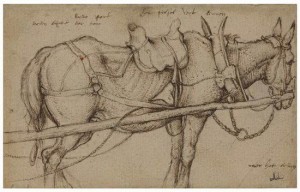 The term ad vivum and its cognates al vivo , au vif , nach dem Leben and naer het leven have been applied since the thirteenth century to depictions designated as from, to or after (the) life. This one and a half day event will explore the issues raised by this vocabulary in relation to visual materials produced and used in Europe before 1800, including portraiture, botanical, zoological, medical and topographical images, images of novel and newly discovered phenomena, and likenesses created through direct contact with the object being depicted, such as metal casts of animals.
The term ad vivum and its cognates al vivo , au vif , nach dem Leben and naer het leven have been applied since the thirteenth century to depictions designated as from, to or after (the) life. This one and a half day event will explore the issues raised by this vocabulary in relation to visual materials produced and used in Europe before 1800, including portraiture, botanical, zoological, medical and topographical images, images of novel and newly discovered phenomena, and likenesses created through direct contact with the object being depicted, such as metal casts of animals.
It is has long been recognised that the designation ad vivum was not restricted to depictions made directly after the living model, and that its function was often to advertise the claim of an image to be a faithful likeness or a bearer of reliable information. Viewed as an assertion of accuracy or truth, ad vivum raises a number of fundamental questions about early modern epistemology—questions about the value and prestige of visual and/or physical contiguity between image and original, about the kinds of information which were thought important and dependably transmissible in material form, and about the roles of the artist in this transmission. The recent interest of historians of early modern art in how value and meaning are produced and reproduced by visual materials which do not conform to the definition of art as unique invention, and of historians of science and of art in the visualisation of knowledge, has placed the questions surrounding ad vivum at the centre of their common concerns.
This event will encourage conversation and interchange between different perspectives involving a wide range of participants working in different disciplines, from postgraduate students to established academics. It seeks to encourage dialogue and debate by devoting a portion of its time to sessions comprising short, 10-minute papers, which will allow a variety of ideas and areas of expertise to be drawn into the discussion.
Topics may include, but are not limited to:
• The role of images, including book illustrations, described as ad vivum in early modern natural history, geography, cosmography, medicine and other investigative disciplines
• The meanings of ad vivum in relation to sacred images, portraiture, landscape depiction, animal imagery, and other types of subject matter involving a claim to life-likeness
• The connections between ad vivum and indexical images: death masks; life casts; the moulage; auto-prints made from natural phenomena
• The connections between concepts of ad vivum and graphic media: the print matrix; imitation and reproduction in print; drawings, diagrams which claim to be ad vivum
• The concept of ad vivum in cabinets of curiosities, sets and series, other groupings and collections
• The application of the phrase ad vivum and its cognates to specific images, and usages and discussions of the terminology in early modern texts
• The use of ad vivum in relation to images of the marvellous and the incredible, including monsters and other prodigies of nature
We invite proposals for:
1) 20-minute papers
2) Short, 10-minute (maximum 1,000-word) papers which will address one example or theme, or make one argument persuasively.
Please send proposals of no more than 250 words by 15 August 2014 to joanna.woodall@courtauld.ac.uk and thomas.balfe@courtauld.ac.uk .
The Courtauld Institute of Art, London, 21–22 November 2014
Proposals due by 15 August 2014
Organised by Joanna Woodall and Thomas Balfe

Leave a Reply
You must be logged in to post a comment.